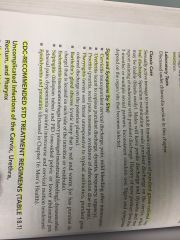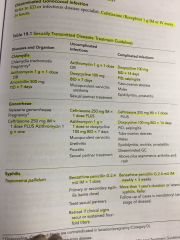![]()
![]()
![]()
Use LEFT and RIGHT arrow keys to navigate between flashcards;
Use UP and DOWN arrow keys to flip the card;
H to show hint;
A reads text to speech;
40 Cards in this Set
- Front
- Back
|
HIV/AIDS |
The median time between HIV infection and AIDS is 10 years. AIDS is defined as an absolute CD4 cell count of less than 200 along with other certain opportunistic infections and malignancies. Signs and symptoms: oral candidiasis, fever, weight loss, diarrhea, cough, shortness of breath, purple to bluish-red bumps on the skin. |
|
|
Acute retroviral syndrome |
Primary HIV infection: An acute and brief illness that occurs and 50% to 80% of persons within a few weeks after exposure to the HIV virus. Very infectious during this time. Due to extremely high viral load and high concentration of virus in genital secretions. The initial immune response may mimic mononucleosis. During this time antibody test may still be negative. If strongly suspect acute HIV infection, order HIB polyamerase chain reaction PCR. Majority develop antibodies within three months after exposure. |
|
|
Disseminated gonococcal disease |
Disseminated gonorrhea: sexually active adult from high-risk population complains of petechial or pustular rash lesions of hands/soles, swollen, red, and tender and joins in one large joint such as the knee. Maybe accompanied by signs of STD. If pharyngitis will have severe sore throat with green exudate that does not respond to usual antibiotics used for strep throat. |
|
|
Chlamydial trachomatis
|
Most chlamydial infection are asymptomatic. That has problems with among persons 25 years of age or younger. This is the most common STD in the United States. It is an obligate intracellular bacteria or atypical bacteria. Possible site of infection: Female: cervix, endometrial, fallopian tube, PID. Males: epididymitis and prostatitis Complications: P ID, tubal scarring, ectopic pregnancy, infertility, reiter's syndrome in males. |
|
|
Laboratory Testing for both Gonorrhea and Chlamydia |
Nucleic acid amplification test (NAAT) are highly sensitive for both GC and Chlamydia. Swab samples can be collected from the urine, cervix, urethra, oral and rectal sites. Urine: collect the first part of the urine stream GenProbe: Use only for the cervix or urethra Thayer-Martin Culture or chocolate agar culture used for Gonorrhea. |
|
|
Treatment plan: Uncomplicated Infections Chlamydia |
Chlamydia: No test of cure is necessary for azithromycin or doxycycline regimen. Azithromycin 1 g PO x 1 or Doxycycline 100 mg BID x 7 days
|
|
|
Treatment for sexual partners: Chlamydia |
Azithromycin 1 gm PO x 1 "Expedited partner treatment" |
|
|
Pregnant women: Chlamydia |
Test of cure 3 weeks after completion of treatment if pregnant. Azithromycin 1 gm PO x 1 or Amoxicillin 500 mg PO TID x 7 days |
|
|
Complicated Chlamydial Infections (PID) |
Rocephin 250 mg IM x 1 plus Doxycycline PO BID x 14 days with or without Flagyl PO BID x 14 days |
|
|
Neisseria Gonorrhoeae |
A gram-negative bacterium that infects the urinary and genital tracts, rectum, and pharynx. Unlike chlamydia, gonorrhea can become systemic or disseminated if left untreated. If positive for N. gonorrhea, cotreat for both even if negative chlamydial test because of high rate of coinfection. |
|
|
Gonorrhea Signs and Symptoms |
Purulent green-colored vaginal discharge. Speculum examination reveals purulent discharge on the cervix, which may be friable or bleed easily. Males will have penile discharge and dysuria and may report staining of underwear.
|
|
|
Signs and Symptoms of Gonorrhea by Site |

|
|
|
CDC recommended STD treatment Regimens |
Uncomplicated infections of the cervix, urethra, rectum, and pharynx: (If pharyngeal infection, use only the first -line regimen) First line: Rocephin 250 mg IM x 1 Plus cotreat for chlamydia Plus Azithromycin 1 g PO x 1 or Doxycycline 100 mg PO x 7 days
Test of cure: Repeat test in 3-4 weeks after treatment. Not needed if treated with approved CDC regimen. |
|
|
Complicated Conococcal Infections (PID, acute epididymitis, acute prostatitis, acute proctitis) treatment: |
Rocephin 250 mg IM x 1 dose plus cotreat for chlamydia Doxycycline 100 mg PO BID x 14 days with or without Flagyl 500 mg PO BID x 14 days |
|
|
Sexually transmitted diseases: Treatment guidelines |

|
|
|
Fitz-Hugh-Curtis Syndrome (perihepatitis) |
Chlamydial and or gonococcal infection of the liver capsule resulting in extensive scarring between the liver capsule and abdominal contents. Scars look like violin strings. A complication of disseminated GC and or PID.
RUQ pain and tenderness on palpation. Treated as complicated gonorrheal/chlamydial infection (14 day treatment) |
|
|
Jarisch-Herxheimer Reaction |
Acute febrile reaction that can occur during the first 24 hours after treatment (more likely to occur with treatment for syphillis). Look for fever, chills, headache, myalgias. An immune-mediated reaction that usually resolves spontaneously. Treatment is supportive. |
|
|
Reiter's Syndrome |
More common in males. An immune-mediated reaction secondary to infection with certain bacteria that spontaneously resolves. Treatment is supportive.
Patients complain of dry and swollen joints that come and go and ulcers on the skin of the glans penis.
Mnemonic: I can't see, pee, or climb up a tree. |
|
|
PID follow up exam |
After treating a patient for PID, follow up within 2 to 3 days and perform vaginal bimanual examination. |
|
|
Syphilis |
Screen for syphilis if HIV infection, men who have sex with men, presence of any genital ulcer, previous STD, pregnancy, IV drug use, or high risk. Treponema Pallidum infection. Becomes systemic if untreated.
|
|
|
Primary Syphilis |
Painless chancre with clean base, well demarcated with inddurated margins. |
|
|
Secondary Syphilis (>2 years) |
Condyloma lata (infectious white papules in moist areas that look like white warts). Maculopapular rash on palms and soles that is not pruritic. |
|
|
Latent stage Syphilis |
Asymptomatic but will have positive titersT |
|
|
Tertiary Syphilis (3-10 years)
|
Neurosyphilis, gumma (soft tissue tumors), aneurysms, valvular damage. |
|
|
Syphilis Labs: |
Screening test: RPR or VDRL Diagnostic test: FTA-ABS or DFA-TP. First order screening test RPR or VDRL. If reactive, next step is to confirm with FTA-ABS. Both RPR and FTA-ABS are positive: diagnostic for Syphilis. Do not switch tests |
|
|
Syphilis Treatment |
Penicillin G 2.4 million units IM x 1 |
|
|
HIV infection |
US: HSV-1 is most common Africa: HSV- 2 most common
Viral load: Number of HIV RNA copies in 1 mL of plasma. Test measures actively replicating HIV virus, progression of disease and response to antiviral treatment.
The best sign of treatment success is an undetectable viral load (<50 copies/mcL) |
|
|
CD4 T-Cell counts |
Used to stage HIV infection and to determine when to start prophylaxis.
CD4:CD8 Ratio: Used to monitor depletion of CD4 cells (compared with CD8 cells). Immunocompetent with ratios of >1 HIV-infected usually have ration <1 |
|
|
Screening test for HIV |
ELISA test- highly sensitive for HIV |
|
|
Confirmatory test for HIV |
Western Blot- antibody test with high specificity for HIV. If positive... order HIV PCR/HIV RNA
6 weeks to 6 month- window period |
|
|
Diagnostic tests for HIV |
HIV PCR- if ELISA and western blot positive, order HIV PCR. Detects HIV-1 RNA (Actual viral presence) Infants of HIV positive mothers High risk patient with negative ELISA or Western Blot test. |
|
|
Prophylaxis for opportunistic infections |
Pneumocystits jerovecii pneumonia CD4 lymphocyte count is <200
First line: Bactrim DS one tab daily. (sulfa reaction, next step is Dapsone 100 mg daily or atovaquone suspension).
Toxoplasma gondii infections CD4 count is <100 Fist line: Bactrim DS one tablet daily. Causes brain abscesses |
|
|
Monitoring Viral load: HAART or ART |
check every 1-2 months until viral load is undetectable, then every 3 to 4 months. |
|
|
Post exposure prophylaxis |
Labs for r/o HIV
Use HAART regimen within 72 hours after exposure with zidovudine (ZDV, AZT) + lamivudine (3TC) plus tenofocir (viread) OR Combivir (ZDV+ lamivudine) plus tenofovir (Viread). - Drug class: nucleoside reverse transcriptase inhibitors (NRTIs). |
|
|
HIV infection: Pregnant women |
Safest drug during pregnancy is zidovudine (Retrovir, ZDV, AZT)- started in second trimester Newborns: start treatment with zidovudine (AZT) within first 6-12 hours of delivery. |
|
|
Condyloma Acuminata (genital warts) |
HPV high risk oncogenic types are 16 and 18
Most are caused by HPV 6 or 11.
Meds: Condylox 0.5% gel or cream. Aldara 5% cream - thin layer 3 x/week at bedtime for up to 16 weeks. Cryo, bichloroacetic, or trichloroacetic acid done in office. |
|
|
Cervical cancer screening: pap smear |
Koilocytotic changes (large cell nuclei) seen on Pap smear may signify HPV. Check for HPV and refer for colposcopy.
Colposcopy: microscope to evaluate the cervix and to obtain both endocervical and cervical tissue biopsies. |
|
|
Herpes Simplex |
Asymptomatic shedding also occurs intermittently and patient is still contagious.
HSV-1: Usually oral HSV-2: Usually genital
May have itching on site. Sudden onset of groups of small vesicles sitting onan erythematous base. |
|
|
Herpes Simplex treatment: |
Diagnostic test: Herpes viral culture or RPR assay for HSV-1 and HSV-1 DNA (more sensitive)
Tzanck smear: old test, shows multinucleated giant cells
First Episode: Zovirax 400 mg 3x/day for 7-10 days Famvir 1g BID for 7-10 days Valtrex TID for 7-10 days
Episodic treatment: Famvir 125 mg BID for 5 days Zovirax BID or TID for 7-10 days
Suppressive treatment: Zovirax 400 mg PO BID or Famvir 250 mg PO BID |
|
|
Bacterial vaginosis microscopic |
Squamous cell stippling with indistinct borders no rods and increased white blood cells |

